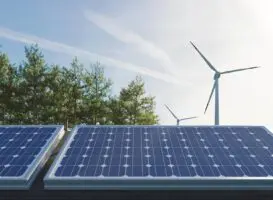Newly constructed solar farms and at least one major wind farm in western Victoria and western NSW have been warned that network losses with worsen next financial year, in an early appraisal of likely marginal loss factors.
The warning from the Australian Energy Market Operator – in an advisory posted late Friday – will deepen the problems facing some wind and solar projects in the region, who have already been hit by significant network losses due to growing congestion, and in some cases have had their output cut in half because of separate “system strength” issues.
The new advisory from AEMO provides “indicative” marginal loss factors (MLFs) for the 2020-21 financial year and is clearly designed as an early warning for existing and prospective investors and developers. The final decision will be made in April.
It warns that MLFs will be cut to as low as 0.725 for facilities such as the Broken Hill solar farm. This means that less than three quarters of its output will be credited with revenue. It’s a massive haircut for its respective business models.
Others to be badly affected include the Bannerton, Wemen and Karadoc solar farms in Victoria, all downgraded to around 0.793, and which – like the Broken Hill facility – have also suffered from the 50 per cent output cut imposed because of newly discovered “system strength” issues that they hope can be resolved by changes to inverter settings.
Others to be badly affected in the new MLF ratings are the Colleambally, Finley and Griffith solar farms in south western NSW, and the Silverton wind farm near Broken Hill, which has proved a problem area for the AGL-sponsored PARF investment group, which owns the Silverton and Broken Hill solar farms and has had to watch output heavily constrained and discounted.
And AEMO warns the situation could get worse, both in north-west Victoria, but particularly for western NSW.
“South-west New South Wales has again seen the largest reductions in the region, compounded by both an increase in imports from Victoria and a large increase in generation capacity within the area,” it says. “The average reductions in south-west New South Wales is 1.83% for load and 2.97% for generation.
“While no additional generation has been considered in south-west New South Wales for the indicative 2020- 21 MLFs, all new generators included in the 2019-21 MLF study will be operational for the full FY in 2020-21, resulting in significantly increased generation levels in the area.
“It is expected that if further generation (except for storage) were to connect in south-west New South Wales, the MLFs in this area would see further declines. Given the historical sensitivity of the area, it is expected that any reductions resulting from increased generation capacity would be more severe than if located in other locations in the NEM.”
It’s not all bad news for the country’s wind and solar farms. Many located in other regions have actually received an increase in MLFs, with north Queensland – an area that has suffered in recent years – enjoying an average increase in MLFs thanks to lower thermal generation, and a reduction in exports to NSW.
In Queensland, there was good news for 15 solar farms, with the biggest gains enjoyed by the Hayman, Daydream, Kidston, Ross River and Hughenden solar farms. The Sun Metals solar farm, which helps power the zinc refinery, had its rating lifted to 1.005, and the Sunshine Coast solar farm, which supplies the local council, also maintained its plus one rating.
NSW also benefits from an average increase of nearly 3 per cent, thanks to those reduced imports from Queensland, and Victoria. Among those to benefit were the White Rock wind and solar farms, and the Sapphire wind farm, all located in the New England area, and the Moree solar farm.
Most wind and solar projects in South Australia suffered minor falls in their MLFs, which mostly are pretty strong between 0.95 and 0.97 (with the exception of the Wattle Point wind farm – 0.81, and the Tailem Bend solar farm, which has a positive rating of 1.00002 – although the solar farm is obliged by its contract to turn off when wholesale prices go negative).
Interestingly – the newly installed Lake Bonney battery suffered the worst downgrade in South Australia, although the Gannawarra battery in Victoria enjoyed the biggest upgrade, and now has a positive MLF of 1.01 (from 0.96).
The publication by AEMO is likely to set off another round of debate and controversy over MLFs, their structure and method of calculations and what should replace them in the future.
The market rule-maker, the Australian Energy Market Commission delayed a decision on what might replace MLFs after 25 large investors wrote that the apparent favoured option – dynamic or locational pricing- could kill investment because of the variability and uncertainty. They suggested a system of “average” pricing, saying it would better reflect what actually happens on the grid.
The AEMC, however, has also suggested complex locational pricing in its “Cogati” proposals which are designed to marry generation and network investments. But its findings have also been described as ham-fisted and inappropriate, and are being strongly challenged by most in the industry. A recent poll found that 90 per cent of stakeholders rejected the AEMC proposals.










